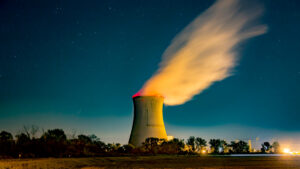ASX Green Energy Stocks: Origin Energy brings forward closure of Australia’s largest coal-fired power plant

Origin Energy's 2,880 megawatt Eraring plant in NSW will now close in 2025. Pic: Getty
The largest of 16 remaining coal power plants supplying the National Energy Market (NEM) – Origin Energy’s’ (ASX:ORG) Eraring in NSW’s Hunter Valley – will close seven years ahead of schedule, following “rapidly changing conditions” that are not well suited to “traditional base-load power stations”.
In a market announcement this morning, which underlined a $131 million loss for ORG over the first six months of FY22, Origin said although plans had been made to close the Eraring Power Station in 2032, the company’s newly proposed exist from coal in August 2025 highlights the rapid transition of the NEM as Australia moves towards cleaner sources of energy.
all the coal closure dates are being moved up.
australia’s largest will be shut in 2025… expect most to be gone by 2030.https://t.co/N2e46WK3x4
— simon holmes à court (@simonahac) February 16, 2022
Large scale battery up to 700MW to take place
“Australia’s energy market today is very different to the one when Eraring was brought online in the early 1980s, and the reality is the economics of coal-fired power stations are being put under increasing, unsustainable pressure by cleaner and lower cost generation, including solar, wind and batteries,” Origin’s CEO Frank Calabria said.
“The cost of renewable energy and battery storage is increasingly competitive, and the penetration of renewables is growing and changing the shape of wholesale electricity prices, which means our cost of energy is expected to be more economical through a combination of renewables, storage and Origin’s fleet of peaking power stations.
“To enable Origin to support the market’s continued transition to renewables, we intend to utilise the Eraring site beyond any retirement of the coal-fired power station, with plans to install a large-scale battery.”
Calabria said after weighing Eraring’s future for some time following consultations with the NSW government to identify the best path going forward, plans are now well-advanced for a battery of up to 700 MW to take its place.
As it stands Origin’s restoration and rehabilitation plans for the Eraring site is around $240 million, based on the previous closure date of 2032.
These costs will continue to be reviewed, the company said, and are expected to be incurred over several years post any closure, with the timing dependent on a potential battery investment and ongoing ash dam operations.
ORG will also seek to “bring online additional renewable and storage capacity, including a potential expansion of the Shoalhaven pumped hydro scheme through the NSW Roadmap process”.
The Shoalhaven Scheme is a dual-purpose water supply and pumped-storage hydroelectricity scheme, which comprises two hydro power facilities with total generating capacity of up to 240 megawatts.
Funded by Arena and currently in stage-2 works, the scheme will explore the commercial feasibility of the preferred option, which will include determining the final design and capital costs and may lead to a final investment decision.
Eraring emits more than 11Mt of carbon dioxide annually – around 8% of NSW’s total.
Gas and LNG still in the mix
The move comes a week after AGL Energy (ASX:AGL) brought forward the coal closure dates at both the Bayswater plant in NSW’s Hunter Valley and its Loy Yang A coal-fired power station in southeastern Victoria.
But while both ORG and AGL prepare to get rid of their dirtiest plants, both still have fingers in the gas and LNG pie.
Climate Council councillor and Macquarie University senior lecturer Dr Madeline Taylor said it is increased storage that we need, not more investment in “expensive electricity generation stemming from gas which our carbon budget cannot afford and may leave us with stranded assets”.
“Coal is not going to cut it anymore when we have cheap and reliable renewable energy and storage that’s already powering over a third of Australia’s largest electricity grid and providing almost 25 per cent of NSW’s power,” Taylor said.
“States and territories are investing in storage technologies and that needs to continue.”
Related Topics
UNLOCK INSIGHTS
Discover the untold stories of emerging ASX stocks.
Daily news and expert analysis, it's free to subscribe.
By proceeding, you confirm you understand that we handle personal information in accordance with our Privacy Policy.








